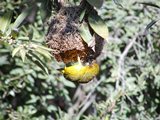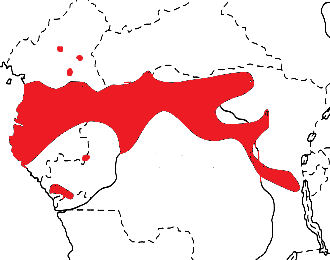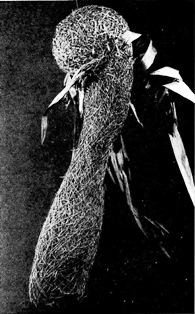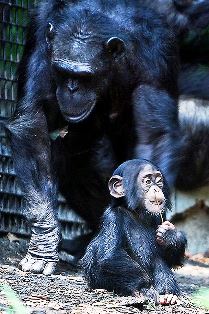Weaver species
Choose different species from drop-down list and press 'Go' button. See Full species list.Cassin's Malimbe Malimbus cassini
IUCN: Least concern Discovery: 060Categories: long tube, black, white eggs, cooperative, Malimbus, fruit, palm,
News items about species
Discovery
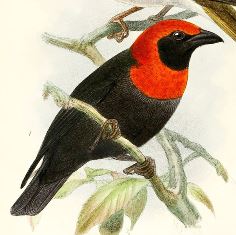
figure from Elliot (1876) 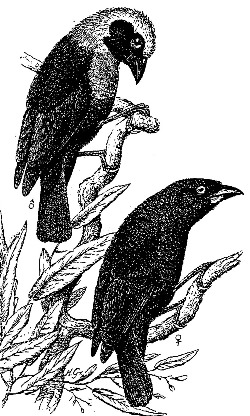
figure from Bannerman (1949) 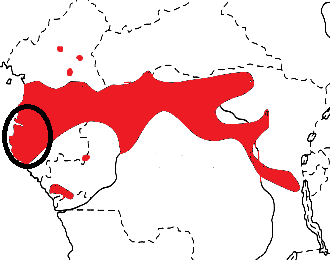
distribution, type locality circled IntroductionCassin's Malimbe was formally described by Daniel Giraud Elliot, an American zoologist. Elliot named this species after John Cassin, an American ornithologist and curator of the Academy of Natural Sciences of Philadelphia (ANSP), now Academy of Natural Sciences of Drexel University.Cassin's Malimbe had been collected for and purchased by one of the Verreaux brothers. It had been collected in Gabon in May 1859. One of the active collectors there was Paul Belloni Du Chaillu, a French-American traveler, zoologist, and anthropologist. Du Chaillu explored West Africa from 1855-59 near the equator, especially around Gabon, so he is the likely collector. Only the male was described initially, and the female was described many years later. The first illustration was of a male Cassin's Malimbe by Elliot (1876), a few years after he described the species. The next illustration was published many decades later by Bannerman (1949), and pictured both male and female, although not in colour. Scientific citationSycobius cassini Elliot 1859, Ibis, 1859, p.392 Gabon.Meaning of namescassini - After John Cassin (1813-1869) US ornithologist, who described several weaver species.First English nameBlack-throated Malimbe (Sclater 1930), decades after it was first described.Alternate namesBlack-throated Malimbe.Collectorvia the Verreaux business, possibly collected by Du Chaillu.Date collectedMay 1859.Locality collectedGabon.Type specimensThe type specimen is in the British Museum (BM 1859.6.28.12). |
The above is based on Weaver Wednesday 2, a weekly series about the discovery of each weaver species.
This species text first appeared as
Weaver Wednesday [177] - Discovery [60]: Cassin's Malimbe on 2015-11-04
1. Basic biology

figure from Elliot 1876 Identification. Cassin's Malimbe is red and black in the male and all black in the female. The male has a black face surrounded by a red head, collar and breast - it is similar to the Red-vented Malimbe but has a black vent. The female Cassin's Malimbe resembles the black Maxwell's Black Weaver and male Vieillot's Black Weaver but the eye is dark, the bill is shorter and more slender, and the feet dark in the malimbe. Cassin's Malimbe is almost indistinguishable from the female Red-crowned Malimbe, and it is best to see both male and female together to confirm identification. The immature Cassin's Malimbe has a pale red or orange head. Distribution.
Cassin's Malimbe occurs in Cameroon, Central African Republic, Equatorial Guinea, Gabon, PRCongo, and DRCongo along major rivers (see map below, based on Birds of Africa). There are no subspecies.
Habitat. Cassin's Malimbe inhabits dense, tall primary forest, often in swampy areas or in forest areas that are prone to seasonal flooding near watercourses. It is associated with wine palms, oil palms and climbing rattan palms. Food. Cassin's Malimbe feeds mainly on insects, including crickets and grasshoppers, mantids and moths. It has been seen feeding on fruits of the oil palm in PRCongo. It forages in pairs or small groups at middle levels and in the canopy, but may also venture into more open areas. Cassin's Malimbe regularly joins mixed-species flocks. Breeding.
Cassin's Malimbe is apparently monogamous. Nest-building is initially co-operative, often with one female and several males building simultaneously. The dominant male then displaces the other birds, and remains with a female. Nest construction takes up to 15 days. The nest is very distinctive, and considered to have the most regular weaver of all weaver nests. The nest has a very long, transparent tunnel that hangs vertically downwards (up to 1 m).
The nest is finely woven from stiff material. The egg-chamber is lined with green palm strips, woven in several layers of short, broad strips of material. The tunnel is woven of one layer of fine, long strips from palm fronds, with fibres projecting loosely at the end of the tube. The nest is attached 10-25 m above the ground in climbing palms or other trees. The female strips the leaves around the nest. Nests may persist for several seasons, and thus several may be seen close together, although only the newest nest appears to be used for breeding; old nests may be used for roosting. The clutch is 2 eggs, which are pure white (few weaver species lay only white eggs). Incubation is by both sexes, with incubation bouts of nearly 1 hour at a time. The chicks are fed by both sexes. In a Gabon study, most nests were robbed by chimpanzees Pan troglodytes. |
The above is based on Weaver Wednesday, a weekly series about weaver species.
This species text first appeared as
Weaver Wednesday [108]: Cassin's Malimbe on 2014-07-09
2. Breeding facts
| Pair bond Apparently monogamous Breeding season Nov-Mar in Gabon and Sept and Nov in PRCongo: in DRCongo, Nov in N but Sept-Feb in E (Itombwe region) Nest site attached 10-25 m above ground to spiny petioles of climbing palm Nest building Initial co-operarive nest-building; dominant male then displaces others, and remains with female. Nest construction evidently regularly involves one female and several males; more than one individual wotking simultaneously Colony size in Gabon five nests built by a pair, 13 nests by two males with a female, and three by three males and a single female Clutch size 2 eggs Egg colour pure white Egg size 21.8 x 16.3 mm (DRCongo) Incubation incubation by both sexes, stints of nearly 60 minutes recorded, incoming bird calling partner out, no information on duration of incubation period Chicks and nestling period chicks fed by both male and female, no information on duration of nestling period |
Breeding information based on Handbook of the Birds of the World, Vol. 15.
3. Photos of Weaver Nests
No records yet - be the first to submit a PHOWN record!See PHOWN summary page for this species here.
PHOWN (Photos of Weaver Nests) provides valuable info on breeding distribution and colony sizes of weavers.
You can contribute by registering and submitting photos at Virtual Museum webpage.
4. Breeding distribution
Google map showing distribution (For species with small ranges you need to zoom in at the correct area to see the range):
yellow blob - range of weaver species; read more about this here.
![]() - PHOWN records with photos
- PHOWN records with photos
![]() - PHOWN records with no photos (Nest Record Cards, other records)
- PHOWN records with no photos (Nest Record Cards, other records)
![]() - Birdpix records
- Birdpix records
![]() - comments on out of range records, or interesting records
- comments on out of range records, or interesting records
![]() - type locality
- type locality
CLICK on the marker on the map to see individual record details.
5. Range changes
Not South African speciesThe above is based on Weaver Wednesday 3, a weekly series about range changes in South African weaver species.
This species text first appeared as
n/a








